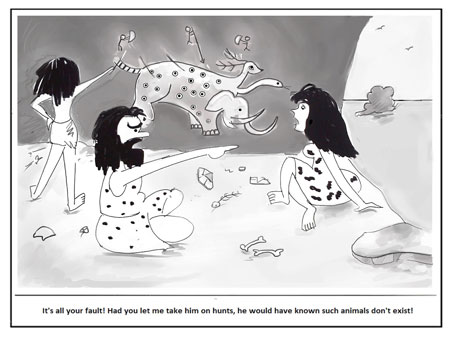WArchaeoGiri begins with a quote from Harriet Beecher Stowe: ‘The past, the present, and the future are really one: they are today.’ Although the reading of history should lead us to this point, we frequently miss the link and get lost in the data that, when interpreted, is somehow devoid of its essential humanity. Shubha Khandekar, trained in archaeology (she participated in excavations in Shringaverpur, Inamgaon and Chandore), and having worked as a journalist, brings both her experiences to a panoramic travel into the past, and reports on it the way a contemporary cartoonist from the remote past would have done; giving us a glimpse into what would have caused historical characters to grumble, gossip or guffaw. Supported by short and lucid text that brings you up to date with the latest developments in Indian archaeology, from the Stone Ages to the contemporary debates on how we look at the past, the cartoons, as the Foreword by renowned archaeologist M.K. Dhavalikar states, make the stones speak.
A guided tour of history
The cartoons take you on a guided tour from the Stone Age to our own times; a span of two million years, and that is some exciting time travel through cartoons. Hence one learns how being a dentist or a mother goddess could have been the cherished career goals for prehistoric kids. Or that a hunter would have sneered at a gatherer as the former wouldn’t stoop to picking tamarind for a pregnant wife. As a prehistoric child prodigy draws an animal with heads, feet and tails of different animals, the exasperated father points a finger at the over-protective mother, saying, ‘It’s all your fault. Had you let me take him on hunts, he would have known that such animals don’t exist.’ Of course, the prehistoric couple would have argued about children and, as in our own times, any perceived shortcomings in upbringing would be blamed on the spouse. Illustrating the complexities of life in the Middle Stone Age as depicted in the thousands of paintings in the rock shelters of Central India, a cartoon shows a man thrown off by a bull, with onlookers commenting on how, when he could not decide on whether to tame the bull, hunt him or paint him, it was the bull who did!

When microliths appeared, hand axes would have become dated. There is a charming cartoon in which the prospective groom protests that even in the age of microliths, the bride’s father demands the obsolete hand axes as bride price, belittling the finer, more advanced microliths as ‘silly little thingummyjigs’.
These cartoons make you laugh and then get you thinking. We throw stones now, at glasshouses and otherwise. It needed the ingenuity, sophistication and versatility of the Stone Age man to fashion these into tools to make choppers, blades, points, sickles, harpoons and arrowheads. He would lament his successors’ sheer waste of resources and the dying of the handicrafts!
Generally, all school students who have been introduced to history know about Chandragupta’s marriage to a Greek princess, who was exchanged for 500 elephants as a return gift. Imagine her plight in a faraway foreign land; the forlorn princess is offering an elderly compatriot who comes visiting her, 600 elephants to buy her out of the place, protesting against the scorching heat of Bihar and the unbearably spicy food!
Buddha’s representations do not belong to his times. He was first depicted through such symbols as the Bodhi tree, footprints and the ‘Dhamma’ wheel. His images date from the time of Gandhara Art, which flowered a few hundred years after he had died. One of the cartoons titled ‘Headers and Footers’ shows a Greek sculptor proudly displaying the Buddha’s head he created, to which the dhoti-clad BCE sculptor responds that at least he does not pretend to know what Buddha looked like! One cartoon shows an irate donor admonishing the impudent engraver, who would rather immortalise his love for Sundari, to stick to the given text about who donated the cave.
We all know Asoka for his rock and pillar edicts, and his message of non-violence. This would have forced a change in food habits and livelihoods. A cartoon shows a Piyadasi Pure Veg Restaurant owner awaiting footfalls, suffering the double whammy of bankruptcy and the wife’s predictable ‘l told you so.’ The famous Trimurti from the Elephanta Caves spout the ‘Copy’, ‘Paste, and ‘Delete’ commands, which summarise the mythological obligations of the holy trinity with exceptional thrift.
Each reader will find his own favourites among the cartoons to chuckle at, but there are two at the very end which particularly catch your attention. One shows the Public Holidays Department considering a Vibhishana ghar wapasi day. The other has two horses contemplating taking the road to Mohenjodaro where Ashutosh Gowarikar has offered them the entire granary.

The cartoons also raise the issues of doctored histories, coloured chronicles and political interference in what is the exclusive domain of archaeologists and historians. If the past is to be rewritten based on ideological preferences and put into our prejudiced templates, we are only depriving ourselves of the picture that may emerge from a dispassionate analysis of data.
The cartoons, however, tell you that you need not let the experts, whether of the Left or the Right disposition, overawe you, and there is a common sense way of looking at the vast stretch of history and time preceding us. The book sends a strong message that we must let the past be and not drag it into the present.
ArchaeoGiri is an irreverent, informative and entertaining take on India’s past and its writing: a must read for scholars, students and lay enthusiasts alike. It is a book that you can pick up any time, open any page and enjoy. This is how history should be taught, with wit, humour and a lot of common sense. The history teachers could possibly look at the cartoons and find new ways to communicate to their students. The cartoons would certainly enliven the classroom. Certainly, the cartoons could be very good ads for the ruins of history. Imagine the horse cartoon put up at a Harappan site!


 [/column]
[/column]